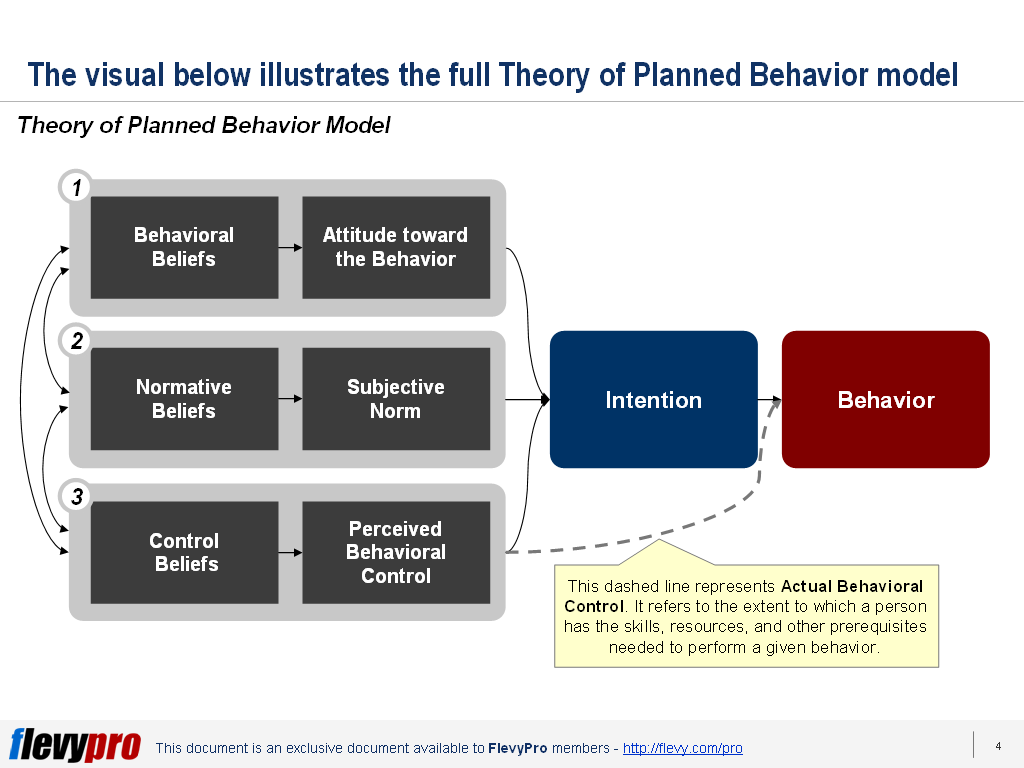Editor's Note: Take a look at our featured best practice, Pricing Strategy (38-slide PowerPoint presentation). Pricing Strategy is a core pillar of Marketing and Product Strategy. It is 1 of the 4 Ps of Marketing (also known as the Marketing Mix - Product, Price, Placement, and Promotion). As such, knowing how to properly price your product is extremely important to the commercial success and viability of [read more]
Also, if you are interested in becoming an expert on Strategy Development, take a look at Flevy's Strategy Development Frameworks offering here. This is a curated collection of best practice frameworks based on the thought leadership of leading consulting firms, academics, and recognized subject matter experts. By learning and applying these concepts, you can you stay ahead of the curve. Full details here.
* * * *
 How can you change the behavior of your customers? Try the Theory of Planned Behavior.
How can you change the behavior of your customers? Try the Theory of Planned Behavior.
The Theory of Planned Behavior (TPB) is an established behavioral psychological theory that links beliefs and behavior. It was developed by Icek Ajzen in 1985 and since been applied to studies of the relations among beliefs, attitudes, behavioral intentions, and behaviors in various aspects of business, such as marketing, public relations, and advertising campaigns; and across numerous industries. TPB has also improved the predictability of intention in various health-related fields, such as condom use, leisure, exercise, diet, etc.
TPB provides a model for understanding how we can change the behavior of people–such as our target customers, our business partners, our management team, our employees, key stakeholders, etc. It is a theory which predicts deliberate behavior, because behavior can be planned.
According to TPB, human behavior is guided by 3 kinds of considerations:
- Behavioral Beliefs. These are beliefs about the likely consequence of the behavior.
- Normative Beliefs. These are beliefs about the normative expectations of others.
- Control Beliefs. These are beliefs about the presence of factors that may facilitate, or may impede, the performance of the behavior.
In their respective aggregates, “behavioral beliefs” produce a favorable or unfavorable “attitude toward the behavior;” “normative beliefs” result in “subjective norm;” and “control beliefs” gives rise to “perceived behavioral control.” Attitude toward behavior, subjective norm, and perceived behavioral control together shape an individual’s intentions and behaviors. The diagram below provides a visualization of TBP and all its components.

What is Intention?
Intentional is an indication of an individual’s readiness to perform a given behavior. It is assumed to be an immediate antecedent of behavior.
Intention is based on attitude toward the behavior, subjective norm, and perceived behavioral control, with each predictor weighted for its importance in relation to the behavior and population of interest.
What is Behavior?
Behavior is an individual’s observable response in a given situation with respect to a given target. Ajzen said a behavior is a function of compatible intentions and perceptions of behavioral control in that perceived behavioral control is expected to moderate the effect of intention on behavior, such that a favorable intention produces the behavior only when perceived behavioral control is strong.
In general, the more favorable the attitude toward behavior and subjective norm and the greater the perceived behavioral control, the stronger the person’s intention to perform the behavior in question should be. Therefore, given a sufficient degree of actual control over the behavior, people are expected to carry out their intentions when the opportunity arises.
It is important to be aware that TPB does have some limitations, such as:
- Factors such as demographics and personality aren’t in this framework
- There is no clear definition of perceived behavioral control (hard to measure).
- The more time between behavioral intent and actually doing the behavior, the less likely the behavior will happen.
- The theory assumes that perceived behavioral control predicts actual behavioral control.
- The theory also assumes people are rational and make systematic decisions based on available information—and ignores unconscious motives.
So, how do you plan to leverage the Theory of Planned Behavior in your work?
You can download an editable PowerPoint about the Theory of Planned Behavior here on the Flevy documents marketplace.

34-slide PowerPoint presentation
Product Lifecycle Analysis is an invaluable tool for developing a robust product marketing strategy. Marketers and strategists can use this analysis to predict sales growth, associated customer and competitor behaviors, and, in turn, devise the appropriate product marketing strategy.
The Product
[read more]
Want to Achieve Excellence in Strategy Development?
Gain the knowledge and develop the expertise to become an expert in Strategy Development. Our frameworks are based on the thought leadership of leading consulting firms, academics, and recognized subject matter experts. Click here for full details.
"Strategy without Tactics is the slowest route to victory. Tactics without Strategy is the noise before defeat." - Sun Tzu
For effective Strategy Development and Strategic Planning, we must master both Strategy and Tactics. Our frameworks cover all phases of Strategy, from Strategy Design and Formulation to Strategy Deployment and Execution; as well as all levels of Strategy, from Corporate Strategy to Business Strategy to "Tactical" Strategy. Many of these methodologies are authored by global strategy consulting firms and have been successfully implemented at their Fortune 100 client organizations.
These frameworks include Porter's Five Forces, BCG Growth-Share Matrix, Greiner's Growth Model, Capabilities-driven Strategy (CDS), Business Model Innovation (BMI), Value Chain Analysis (VCA), Endgame Niche Strategies, Value Patterns, Integrated Strategy Model for Value Creation, Scenario Planning, to name a few.
Learn about our Strategy Development Best Practice Frameworks here.
Readers of This Article Are Interested in These Resources

46-slide PowerPoint presentation
Some innovations are truly spectacular, but consumers are slow or just refuse to adopt. In fact, over 70% of all new products fail in the marketplace--and innovative, new products fail at an even higher rate.
Why is this the case? And, how do companies overcome this?
This document discusses
[read more]

29-slide PowerPoint presentation
This document discusses Rogers' Five Factors, framework for analyzing and understanding the diffusion and adoption of product innovations.
Businesses are interested in understanding how innovations diffuse, so that they can better predict and manage this consumer adoption. A popular framework
[read more]

63-slide PowerPoint presentation
This toolkit is focused on the point at which we actually ask the customer for a price increase. None of the strategic value of a pricing recommendation matters unless we take action with the customer. There are several tools and approaches that could make the increase more successful.
This
[read more]

23-slide PowerPoint presentation
Product Innovation has become everyone's responsibility. But, when everybody owns innovation, nobody owns innovation.
Strategically, Product Innovation now calls for Innovation Management to minimize duplication and confusion. Innovation Management provides clarity and delineation on
[read more]
 How can you change the behavior of your customers? Try the
How can you change the behavior of your customers? Try the 




